Basketball Drill - Michigan State Progressive Transition Drill
From the Coach’s Clipboard Basketball Playbook"Helping coaches coach better..."
This full-court drill from Tom Izzo (Michigan State University) emphasizes transition offense and defense, conditioning, and passing and catching on the move.
Divide into two teams (yellow and white in the diagrams). Keep score with losers running or doing push-ups. If the offense scores or gets fouled, they get one point.
Start as in diagram A below in a 2-on-1 situation. O1 and O2 will try to attack for a lay-up, as X1 tries to prevent it. As X1 rebounds the made or missed shot (diagram B), he makes the outlet pass to either X2 or X3 coming from the sidelines. O1 and O2 sprint back on defense and now we have a 3-on-2 situation (diagram C).
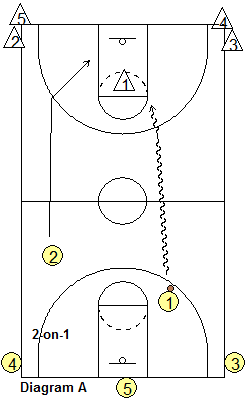
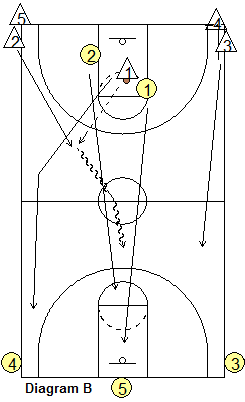
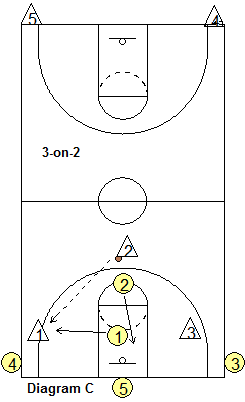
Once the defense rebounds the missed or made shot (diagram D), they advance the ball quickly up the court, with O3 and O4 sprinting onto the court. X1, X2 and X3 sprint back on defense and now we have a 4-on-3 situation (diagram E).
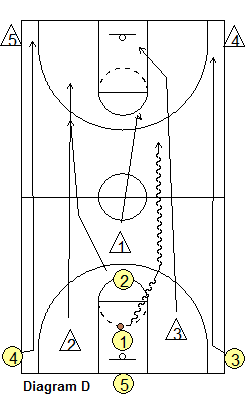
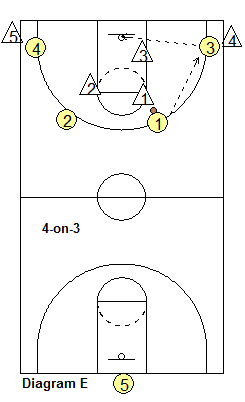
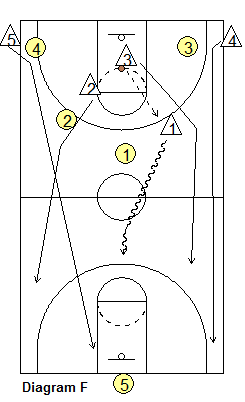
When the X (white triangle) team gets the ball (diagram F), they quickly advance it up the court, as the yellow defenders sprint back on defense. Now white has a 5-on-4 advantage (diagram G).
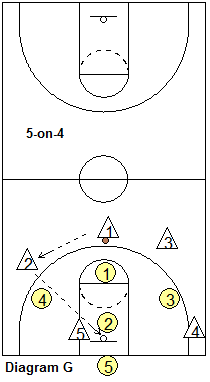
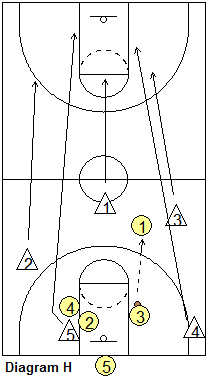
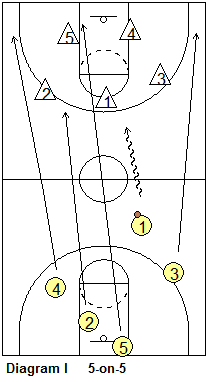
Once the yellow (defensive) team rebounds the missed or made shot, they advance the ball up the court, with O5 sprinting onto the court from under the basket (diagram H). The white defenders sprint back on defense and we are now 5-on-5 (diagram I).
The next series starts with the white team on offense starting out 2-on-1 as in diagram A. Run this drill for 15-20 minutes, or for a specified number of cycles, or you can play to a certain number and the drill is over when the winning basket is made. Losers run or do push-ups.
Transition Defense
For 1-on-2 defense, we have a standard rule: "get as low as the lowest offensive player." This means that if there is an offensive player under the basket, the defender must be down low. We will give the opponent the outside jumper. It is a lower percentage shot than the lay-up, you avoid getting a foul, and you may get the rebound, or delay the offense long enough for your teammate to arrive on defense.Sometimes the defender makes the mistake of coming up away from the basket and challenging the ball, only to get beaten by an easy pass to another player under the basket for a lay-up. The defender must stay back and "gap" the offensive players, hedge, and try to straddle and cut off the passing lanes to the easy lay-up.
For defending the 3-on-2 situation - notice in diagram C above that the defenders O2 and O1 stack with one stopping the ball on top and one under the basket. The low defender will take the first pass, so if the ball is passed to the wing, the low defender sprints out and closes-out on the ball, as the top defender now sprints to the low position under the basket.
This often results in a pass back to the top, and in a real game situation, this delays the offense just enough for our other defenders to get back and help, and we have stopped the lay-up.
When we are at a 4-on-3, or 5-on-4 disadvantage, there are several keys:
- stop the lay-up
- be very vocal, talk and help, communicate
- box-out and rebound the missed shot
Transition Offense
In transition offense, in the 2-on-1 situation, we want the player attacking with the ball to be aggressive and to think first of attacking the hoop for a lay-up or foul, with the pass as the second option. An "in-and-out" dribble move(show video).
In the 3-on-2 situation, we do not want the ball-handler at the top penetrating beyond the free throw line. He should engage the top defender and look for the open pass to either side, and stays at the top as a reverse pass may be necessary. In 4-on-3 and 5-on-4, run the lanes, the sidelines and maintain good spacing. Dribble-drive and dish, or a kick-out pass, are often good things.